Are you building a business around your expertise? This guide reveals the 5 stages of growth for content creators and entrepreneurs (and what to focus on in each stage), featuring insights from successful entrepreneurs and Thinkific clients that have reached 6 and 7 figures in annual revenue.
The opportunity that you have for building a business around your expertise is unprecedented. At no point in history have individuals had access to the tools and technology to build a business and reach a global audience as quickly and inexpensively as they do today.
If you’re someone that has truly honed your craft and wants to share your expertise with others (and get paid for it!), this is the golden age.
But just because there has never been a better time to build a business around your expertise doesn’t mean that doing so is easy. Building a successful business takes dedication, hard work, sacrifice, and resilience that most people aren’t willing to stomach. It’s not crowded at the top for a reason.
Without knowing what stage of building your business you’re in, I’m going to make a few assumptions about you:
✓ You’ve probably spent years (and lots of trial and error!) honing your craft. You’re an expert at what you do, with a track record of results to prove it.
✓ You’re determined to utilize your expertise to help others and to be paid well for doing so.
✓ You’re working hard and you’re often feeling overwhelmed.
And if you’re in the early stages of building your business, there’s a good chance that you’re also:
✓ Tired of working long hours with little progress to show for it.
✓ Tired of working with clients that aren’t a good fit because you need the money.
✓ Tired of watching your competitors win the attention of your target market and then fail to actually help them (leaving a bad taste in their mouth that makes it even harder to earn their trust).
✓ Tired of sacrificing things that are important to you (like traveling or spending time with friends and family) while you hustle to create momentum in your business.
✓ Tired of trying to keep up with all of the latest marketing strategies and tactics that other people are telling you to focus on. You have a bad case of information overload.
The bottom line? Building a business can be extremely stressful and tiring.
But here’s the thing…
If you’re feeling overwhelmed as you’re building your business, that feeling of overwhelm isn’t the real problem. Overwhelm is a symptom of a problem.
The real problem is having unclear priorities. If you’re feeling overwhelmed, you’re likely giving your time and attention to things that do not deserve your time and attention (at least not right now). You’re keeping busy, but you’re not as productive as you should be. You’re working hard, but you’re not working on the things that you should be working on.
When it comes to building a business, there are specific stages that require different priorities. Focusing on the wrong priorities for your specific stage of business is what causes overwhelm and stalls your growth.
Why this isn’t “just another guide” to building a business:
At Thinkific, we’ve had the privilege of supporting tens of thousands of entrepreneurs that are building businesses around their expertise. We’ve also interviewed, surveyed, collaborated, and created content with hundreds of entrepreneurs from dozens of different industries (ranging from tens of thousands of dollars in annual revenue to several million dollars in annual revenue).
In paying close attention to how these entrepreneurs built their businesses, it has become clear to us that no matter what industry or niche an entrepreneur builds their business in, the stages of growth that an expertise-based business goes through are practically identical.
Understanding these stages, and more importantly, what to focus on during each stage, will help you to knowhow to build a successful business around your expertise as quickly and efficiently as possible.
The purpose of this guide, therefore, is not to give you more information (even though there’s a quite a bit of information in it!). It’s to give you clarity.
I encourage you to read this guide slowly, take notes on what you can implement, and bookmark it for future reference.
If this guide ends up being helpful for you, please leave a comment at the bottom to let us know, or share it with any other entrepreneurs in your network that are working hard to build a successful business and that could benefit from some clarity.
Sound good? Okay, let’s dive in.
The Definitive Guide to Building a Business Around Your Expertise (5 Stages of Growth) @TylerBasu #entrepreneurship Click To TweetThe 5 Stages of Building a Business Around Your Expertise
There are 5 specific stages of growth in every business that is built around transferring information and expertise to its clients. Each of these stages come with a unique set of challenges, along with a different set of priorities required to master (and move up from) each stage.
Being aware of these stages and having the discipline to stay focused on the specific priorities that apply to your current stage in business is the key to minimizing overwhelm and creating consistent momentum in your business.
** DISCLAIMER **
The timeframes and income goals at each stage are guidelines (based on the typical results of the entrepreneurs we surveyed). Use them as inspiration to help establish your own goals and gauge your progress, but don’t think of them as definitive rules that apply to all industries or niches.
STAGE 1: Proof of Concept
- Main Objective: To validate your “big idea” by monetizing your expertise
- Typical Timeframe: 3-6 months
- Income Goal: $10,000 – $50,000
The first stage of building a business around your expertise is validating your business idea (aka your “big idea”). In the startup world, this stage is often referred to as proof of concept. Your priority during this stage is to obtain evidence that your big idea is feasible.
To help clarify your big idea, answer these 3 questions:
- What expertise are you most prepared to share with others?
- What problem does your expertise help someone solve?
- Are people willing to pay you to help them solve that problem?
Your big idea should live at the intersection between your expertise, a problem that a specific target audience wants to solve, and a willingness to pay to solve that problem:

What to focus on in this stage:
1. Packaging your expertise into a compelling offer
Creating a compelling offer begins with honing in on a specific area of your expertise that is monetizable. We like to call this area your sweet spot.
To find your sweet spot, identify an area of expertise that you are passionate about and interested in, are highly knowledgeable and skilled (via formal training and real-world experience) and have verifiable results and/or credentials to prove it.
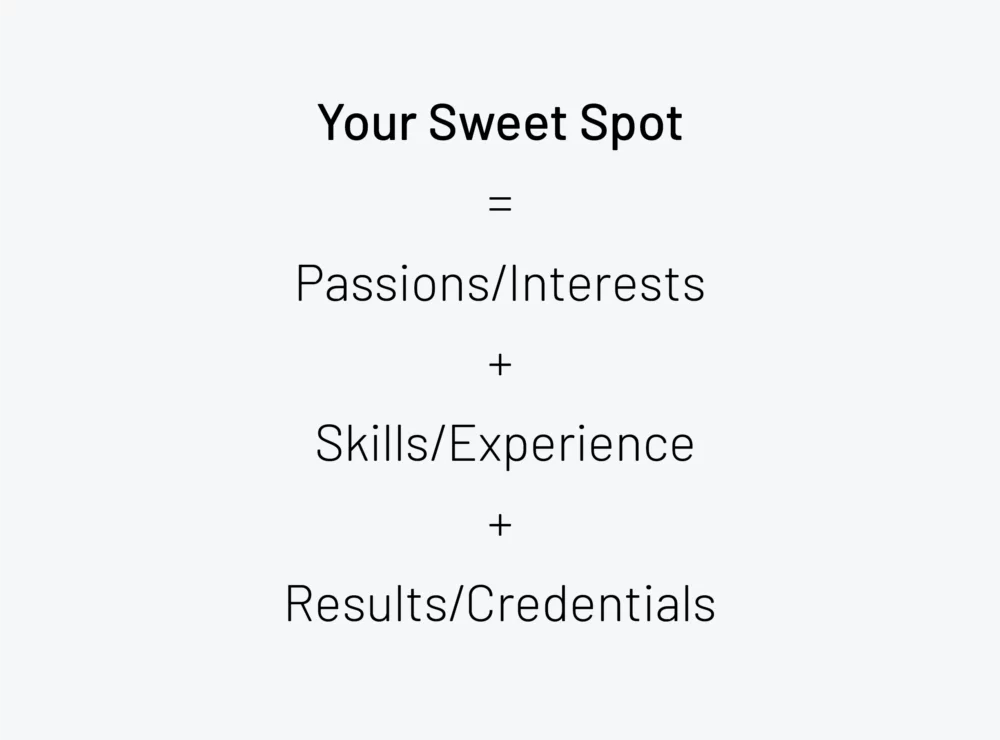
There is a tremendous amount of free information available online on virtually every topic imaginable. Because information is available in such abundance, it is quickly becoming a commodity in most industries.
Therefore, the value of your expertise is not in your information itself, but in your ability to provide the right person with the right information, at the right time, and in the right sequence, enabling them to act on that information and achieve their desired outcome. The value of your expertise is in your ability to help your clients achieve the transformation they desire.
Your clients don’t need more information. They need clarity and results. They need a transformation.
The value of your expertise is in your ability to help someone achieve their desired outcome. Your clients aren’t paying for information, they’re paying for clarity and results. Click To TweetThe key to packaging your expertise into a compelling offer is to stay focused on the transformation you help your clients achieve. Your offer should provide your clients with precisely enough information (nothing extra!) to help them achieve their desired outcome as quickly and painlessly as possible.
As you create your offer, choose one specific outcome that it will help your clients achieve, and then divide the process of achieving that outcome into specific milestones:

2. Identifying your target audience
Once you’ve identified the specific outcome that your expertise can help someone achieve, the next step is to identify a specific target audience that is searching for a way to achieve that outcome.
The greater the frustration associated with not achieving that outcome, the better. When there is a high cost of not solving a problem, there is a stronger and more urgent willingness to pay to solve the problem.
Your job is to identify a target audience for which the cost of not solving their problem is high, that values the outcome you help them achieve, and that can afford to pay you to help them. These are the people that are most likely to purchase your offer when you present it to them.
“The most important phase is your pre-work: surveying your audience to understand what they’re most interested in, and then running a pilot to test demand and ensure you’re providing information that’s relevant and important to them. That will put you on track to create a product people actually want.” – Dorie Clark, Marketing Strategist
3. Validating the demand for your offer
There are two main ways you can validate the demand for your offer: by conducting market research or by selling it.
Although market research does have some benefits, its greatest limitation is that it can only help you gauge the demand for your offer. To prove that there is demand for your offer, you need to sell it.
Until you actually generate revenue, your business idea is still just an assumption. The best way to prove your assumption right is to collect revenue from real clients. Nothing says “this is a good idea” like money in your bank account.
“People will vote with their credit card. If they don’t actually put money down, the idea isn’t validated yet.” – Michael O’Neal, The Solopreneur Hour
To validate the demand for your offer quickly and inexpensively, we recommend selling a high-touch offer. A high-touch offer is one that requires you to work directly with your clients.
Types of high-touch offers:
- In-person workshops and events
- 1-on-1 coaching
- Consulting
- Done-for-you or done-with-you services
Even if these types of offers are not what you intend to offer long-term, there are two major advantages to selling a high-touch offer in the early stages of building your business:
- They generally cost very to little create and fulfill, and they can command higher prices than information products and online courses, resulting in immediate profits that can be reinvested in your business.
- They are tremendously valuable from a market research standpoint. Working directly with clients gives you the opportunity to truly understand the needs and questions of your target audience, and refine your offer based on feedback from clients before promoting it to a larger audience.
Before our CEO Greg Smith co-founded Thinkific, he was working as a lawyer. In his spare time, he was teaching aspiring law school students how to pass the LSAT (law school admissions test) at a local university. Teaching students in a classroom setting allowed Greg to refine his content and prove that he could in fact, help aspiring law students pass the LSAT and get accepted into law school.
It wasn’t until after he taught students in a high-touch environment that he decided to create an online course to reach the broader market of aspiring law students. This led to the creation of Alpha Score, an online LSAT preparation course. In fact, it was Greg’s search for a platform to run his course on that led to the creation of Thinkific, but that’s a whole other story. The point is that he refined his offer in a high-touch environment before he created an offer that he sold to a broader market.
“It takes time and work to build a business. Start small, focus on one thing at a time, and realize that even if it takes a year or two, getting to significant passive income can be amazing. But also don’t think that doing the same thing over and over will have different results. If it’s not working at all, do other things. If it’s working a little, do more and improve.” – Greg Smith, CEO of Thinkific
Note: If you are unable to validate the demand for your offer, you may need to change your target audience, or change your offer, or both. Don’t give up. Keep iterating until you find a winning combination, then move on to Stage 2.
STAGE 2: Specialization
- Main Objective: To become known as the go-to expert in your niche
- Typical Timeframe: 6-12 months
- Income Goal: $50,000 – $100,000
Once you have a proven offer that solves a valuable problem for a specific target audience, it’s time to start positioning yourself as the go-to expert in your niche. The goal here is to become known as a specialist; someone that solves a specific problem for a specific target audience – and who is good at it.
Think of this stage as becoming a big fish in a small pond (versus a small fish in a big pond). Broad markets are highly competitive. Unless you’re one of the first to enter the market, it will be difficult to stand out among your competitors without a significant investment in marketing and branding.
Becoming known as the go-to expert in a specific niche has other advantages as well, including:
✓ Making it easier for others to refer clients to you (because they can clearly describe who you help and how you help them)
✓ Making it easier to build a track record of successful clients (as you refine your offer it becomes more valuable)
✓ Being able to command higher prices for your offer (as your offer becomes more valuable)
“Don’t sell something just because it’s marketable. Find your ONE area of mastery where you can say you’re the best in the world, and don’t do ANYTHING else.” – Russ Ruffino, Clients on Demand
What to focus on in this stage:
1. Developing your unique process
As you work directly with your clients, continue refining your process until you know with absolute certainty that it helps your clients achieve their desired outcome.
The specific process that you guide your clients through becomes your intellectual property (aka your “secret sauce”). Developing your specific process helps to position you as a specialist in your niche and stand out among your competitors. Giving your process a unique name also helps to create the perception that it is proprietary, and therefore, more valuable.
2. Building your brand
For many entrepreneurs, building their brand is one of the most exciting parts of building their business. But there’s a reason why building your brand belongs in Stage 2 and not in Stage 1.
We’ve seen countless entrepreneurs make the mistake of getting excited about their business and immediately start prioritizing creating a new website, designing a logo, ordering business cards, updating their social media profiles, and so on before they’ve validated their business idea by helping real clients. These types of activities are certainly a part of building your brand and positioning you as a go-to expert in your niche, they do not replace actually being an expert.
The most important part of building your brand is that it is authentic, which is why we suggest branding yourself as an expert on [insert your topic here] only after you’ve actually helped others with your expertise. The purpose of building your brand is to position you as the go-to expert in your niche by authentically illuminating your expertise.
“When you build a brand that’s 100% based on you, you lay the foundation to capitalize on your own blue ocean – a space where you can operate in an uncontested marketplace, free from traditional competitive forces – because none of your competitors can replicate or clone all that’s unique and proprietary to YOU.” – Paul Ramondo, Digital Marketing Expert
Your priority when building your brand is to clearly articulate who you help and how you help them. Doing so helps to attract your ideal clients, while simultaneously repelling people that are not your target audience. When a prospective client visits your website or consumes your content, for example, they should feel like they’ve found precisely the person that can help them achieve their desired outcome.
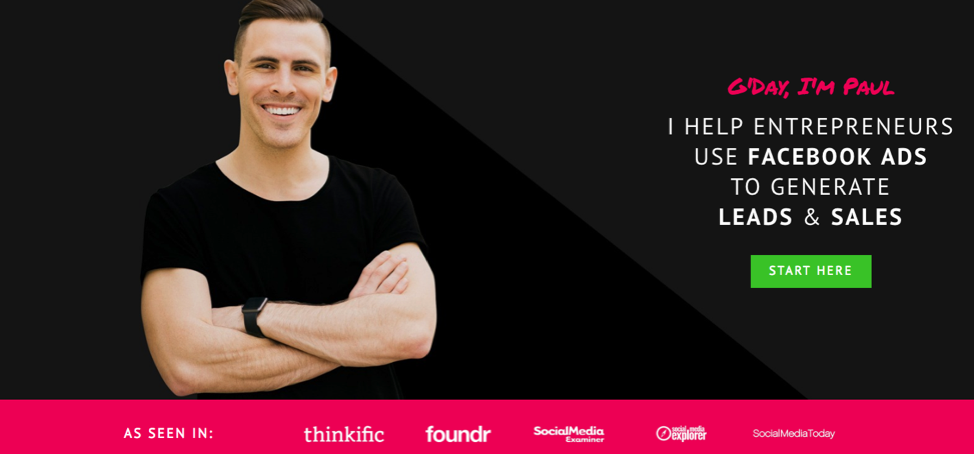
To learn more about how to build your brand, check out our complete guide to building a personal brand here.
3. Collecting social proof
The third component of becoming known as a go-to expert in your niche is social proof. Anyone can call themselves an expert, which is why having other people or organizations endorse your expertise is so powerful. This is why so many of us read customer reviews before we purchase a product. Product reviews are signs of social proof.
There are two primary ways to build social proof for your business:
- Client case studies and testimonials
Every time you use your expertise to help someone achieve their desired outcome, ask them to send you a testimonial that you can add to your website and marketing materials. Even better, ask them if you can share the story of how you helped them publicly as a case study.

- Endorsements from trusted organizations and media
Seek out and seize opportunities to be recognized by other people and organizations in your industry. Writing articles for large publications that your target audience reads, and getting interviewed on podcasts or television, magazines, and radio are all great ways to increase your social proof.
Nicholas Kusmich, for example, is known as one of the world’s leading experts on Facebook advertising, but he didn’t always have this positioning. When he first became an entrepreneur, he was offering marketing consulting services to other businesses. In other words, he was a generalist. As one of the thousands of other marketing consultants, he found it incredibly difficult to stand out and convince prospective clients to hire him.
Shortly after Facebook launched their advertising platform, Nicholas chose to focus exclusively on offering Facebook advertising services to his clients. In doing so, he instantly stood out as a specialist on Facebook advertising. Because he was one of the first to enter a specific niche, his business (and authority) grew significantly. Specializing allowed him to gain a strong foothold in his market, refine his offer, and quickly build a track record of successful clients.
Today, Facebook advertising is a broad niche. Newcomers to this niche have difficulty standing out among thousands of other Facebook advertising experts and service providers. Fortunately for Nicholas, he has an established brand, a proven track record and plenty of social proof, so his business continues to flourish.
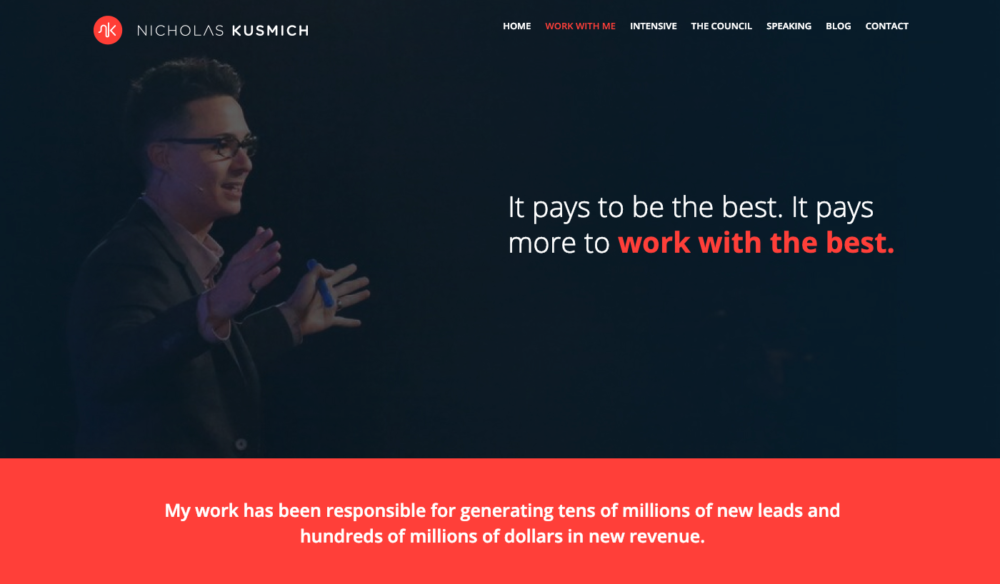
STAGE 3: Audience & Revenue Growth
- Main Objective: To build a system for increasing awareness, leads, and sales
- Typical Timeframe: 12-24 months (1-2 years)
- Income Goal: $100,000 – $250,000
The goal of this stage is to evolve from relying on direct outreach, networking, and referrals to get clients, to building a system for growing your audience and generating revenue predictably and consistently.
As most entrepreneurs that have made it to this stage would agree: you can hustle your way to this stage, but it becomes difficult to sustain it without eventually feeling overworked and overwhelmed.
To minimize the risk of burnout, focus on maximizing the revenue that you earn from working directly with your clients, and reinvesting that revenue into building systems that create predictable growth.
What to focus on in this stage:
1. Growing your audience
Unfortunately, there are plenty of people with large audiences and virtually no business model. They have thousands (and in some cases, millions) of followers online and little or no revenue. These people learn the hard way that the number of followers, subscribers, or website visitors you have are vanity metrics when they don’t contribute to the growth of your business.
The best time to build an audience is when the growth of your audience is tied directly to the growth of your business. Click To TweetFrom what we’ve seen, the most effective way to build an audience of prospective clients is by publishing free content that educates and inspires your target audience. But before you commit to creating content to build your audience, ask yourself these questions:
- What questions and challenges does your target audience have that you can help them with?
- What types of content do they like to consume? (articles, podcasts, videos, etc.)
- What platforms do they spend the most time on? (Facebook, YouTube, Instagram, etc.)
Answering these questions will help you create a content plan that is tailored to your business and target audience.
To learn more about how to create content that attracts your ideal clients, check out our complete guide to epic content creation for entrepreneurs here.
2. Automating your marketing
As you build your audience, you should also be automating your marketing so that as your audience grows, so do your leads and sales. Without a direct correlation to leads and sales, building an audience quickly becomes an unprofitable activity.
Every time you publish and promote free content to help grow your audience, that content should help drive traffic to your website or offers, which helps you acquire leads, which helps you generate sales, creating a profitable cycle of audience and revenue growth:
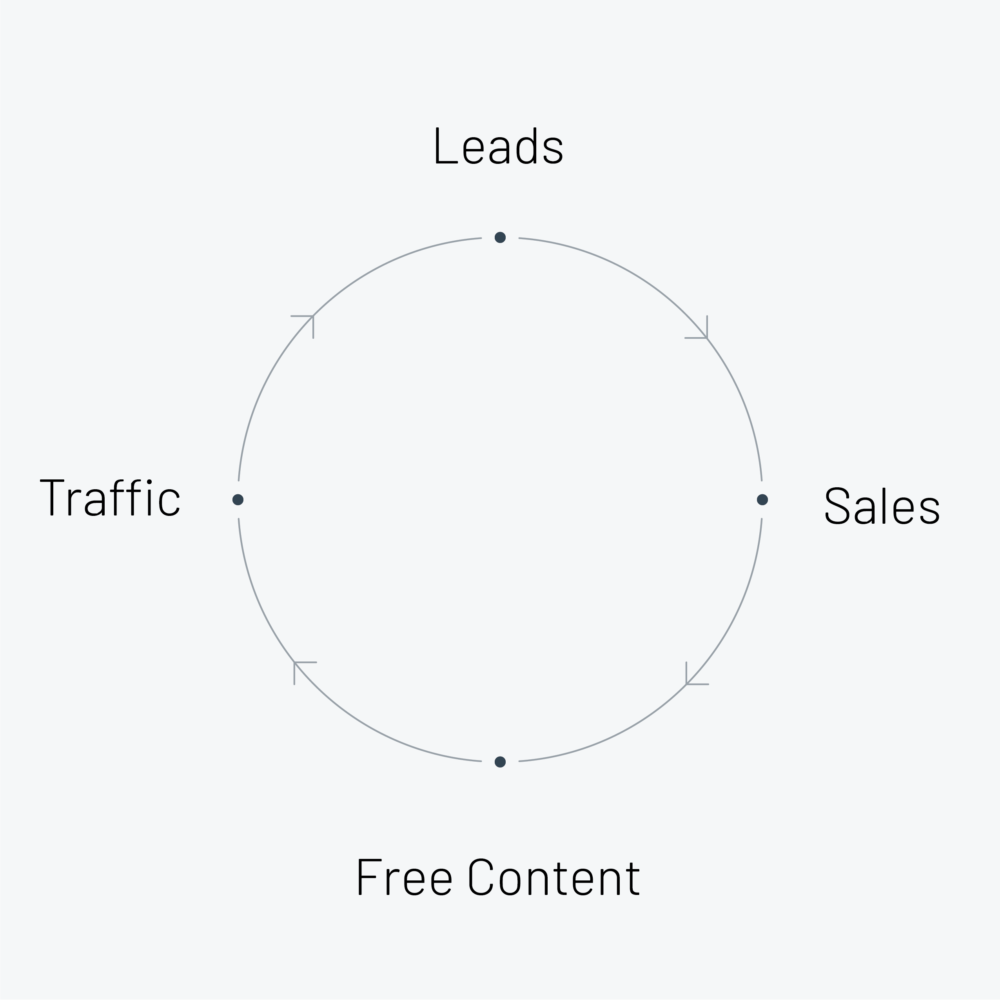
Speed reading and memory skills expert Jonathan Levi, for example, hosts a podcast called Becoming SuperHuman. Visiting his website (where his podcast episodes are published) triggers a retargeting ad that promotes a free webinar. Anyone that registers to watch his webinar becomes a lead, and the webinar itself concludes with an invitation to purchase one of his online courses. Since this entire process is automated, Jonathan can focus on recording new podcast episodes, knowing that each new episode he publishes contributes to his revenue growth.
Case Study: How Jonathan Levi Built a 7-Figure Business Teaching Speed Reading & Memory Skills
“I grew my email list by running Facebook ads directly to a webinar landing page. I ran the webinars almost daily. I reinvested the sales from the webinar I ran on Day 1 right back into more ad spend on Day 2. I was able to quickly ramp up my marketing and grow my list during my first launch. That small list of 150 that I started with has grown to a community of over 50,000 coaches, consultants, authors and experts in an incredibly short period of time.” – Jeanine Blackwell, Create 6 Figure Courses
3. Maximizing revenue from your high-touch offer
Every entrepreneur that reaches this stage in their business soon discovers that there is a very real limit to how many clients they can work with directly. When you trade time for money, you eventually run out of time.
This doesn’t mean that this isn’t a good stage to strive for. For many entrepreneurs, selling a high-touch offer that requires working directly with clients (as a coach, consultant, or service provider, for example) can be incredibly fulfilling. You can earn a respectable income and afford a very comfortable lifestyle at this stage, all while making a positive impact in the lives of your clients.
To reach this stage, there are two specific systems you need to have in place:
- A system for generating leads consistently and predictably (marketing)
- A system for converting those leads into sales (selling)
Having control over these two systems gives you control over your income. Keep growing your audience, filling your pipeline with prospective clients, and selling your high-touch offers until you no longer have the capacity (or the desire) to work with clients directly. And although this is a good problem to have, you will eventually reach a plateau in your growth.
Video marketing expert Sunny Lenarduzzi, for example, started off as a consultant that worked directly with other businesses to help them with their social media and video marketing strategy. But like most service providers that are good at what they do, her calendar eventually filled with client work and she couldn’t accept any more clients even if she wanted to.
By practicing what she preaches, Sunny grew a large audience on social media and YouTube, resulting in even more inquiries from prospective clients. At this point, she knew that the only way to serve more clients was to create offers that didn’t require working with clients on a 1-to-1 basis. This led her to create an online course, moving her business into Stage 4.
Case Study: How Sunny Lenarduzzi Used Video Marketing to Build Her Brand & Business
“You don’t need a big list to get to 6 figures in income but you need to care about people who are on your list and do your best to serve them with excellence. To get to 6 figures pretty much you only need 25 clients at $2,000 and 5 clients at $10,000. If you don’t want to offer high-priced and high-touch programs all you need is 200 customers at the $500 level.” – Iman Aghay, Success Road Academy
STAGE 4: Revenue Acceleration
- Main Objective: To create leverage in your business with a scalable offer
- Typical Timeframe: 24-36 months (2-3 years)
- Income goal: $250,000 – $500,000
The goal of this stage is to accelerate your revenue by escaping the time-for-money that comes from working directly with your clients. This means creating offers that help your clients get the outcome they want without working with you directly (or at least drastically reducing the amount of time that you personally spend with each client).
This stage requires a shift from “working hard” to “working smart” by creating offers that can be sold and delivered to your clients at scale. Creating a scalable offer is the key to building a business that serves hundreds or even thousands of clients at any given time.
What to focus on in this stage:
1. Utilize technology to create online training
In order to serve clients at scale, you’ll need to convert your high-touch offer and convert it into an offer that can be delivered to an unlimited number of clients simultaneously, aka a 1-to-many format.
This is where Thinkific’s online course platform comes in handy. Thinkific allows you to create, market, and sell online courses and programs at scale, while still maintaining complete control of your branding, pricing, and client experience. If you haven’t checked us out yet, you can learn more about Thinkific’s features here.
Types of scalable offers:
- Online courses (one-time purchases)
- Membership sites (for recurring revenue)
- Group coaching (conducted online)
Yes, we’ve seen many entrepreneurs bypass selling high-touch offers and skip ahead to building an online course business. But the entrepreneurs that worked their way up through the previous 3 stages before creating an online program have some pretty significant advantages that make them much more likely to succeed:
✓ They’ve already validated the demand for their offer (and collected revenue from real clients)
✓ They’ve already developed a proven process that can be converted into an online program
✓ They’ve already built a brand, have social proof, and are positioned as experts in their niche
✓ They’ve already built an audience of prospective clients that know, like and trust them
✓ They’ve already built systems for marketing and selling their offers
As you can imagine, for an entrepreneur that has made it through the first 3 stages in this guide, the transition into the 4th stage is a smooth one. I’m not saying that this is the only way to build a successful business selling online courses, but I will say that the majority of Thinkific’s most successful clients have built their business this way.
Related: 5 Ways to Grow Your Business Using Thinkific
“When I launched my first online course, I was an exhausted road warrior traveling virtually every week to consult with clients all over the country. I wanted desperately to get off the road and be home with my family which meant I needed to replace an income fast. The fastest way for you to create a highly profitable online course is to stay laser-focused on the results your clients will invest in achieving. You will be surprised how quickly you can find your ideal clients when you are offering an online course that is specifically designed for them. And the best part is that those amazing, ideal clients will tell you what they want to learn next from you. The development of every new course, program and event I have created since that first online course has been guided by the clients in my community.” – Jeanine Blackwell, Create 6 Figure Courses
2. Automating your sales process
Once you have an offer that can serve people at scale, you’ll need a sales process that can convert leads into clients at scale as well.
When you have an offer that can be sold to hundreds or even thousands of clients, it is no longer feasible for you to personally speak with every prospective client. In other words, something (or someone) other than you needs to be doing the selling.
This is why entrepreneurs at this stage build sales funnels that rely on webinars, video sales letters, sales pages, free trials, or hired salespeople to enroll new clients into their products and programs.
“Online marketing and lead generation is about creating an automatic delivery of an experience that turns a stranger into a customer.” – Scott Oldford, Business Strategist
3. Profit-maximizing
Profit-maximizing refers to the process of increasing the lifetime value of your clients. Having multiple offers and varying price points can also help to reduce your marketing costs because it costs significantly less to sell to an existing client than it does to acquire a new one.
Most entrepreneurs in this stage have more than one offer that helps their clients solve the same problem with varying degrees of support (not to be confused with creating offers that solve different problems for different target markets).
Up-sells, down-sells, and cross-sells ensure that each new and existing client is given the opportunity to purchase other products or services from you, increasing their lifetime value to your business in the process.
“When I reached 6 figures in annual sales, I had 4,100 people on my email list, 3 courses (ranging from $100 to $360), and a handful of eBooks (priced from $5 to $60). Many of my eBooks and courses built upon each other, so a client often purchased multiple products from me in a short time period.” – Regina Anaejionu, Online Business Coach
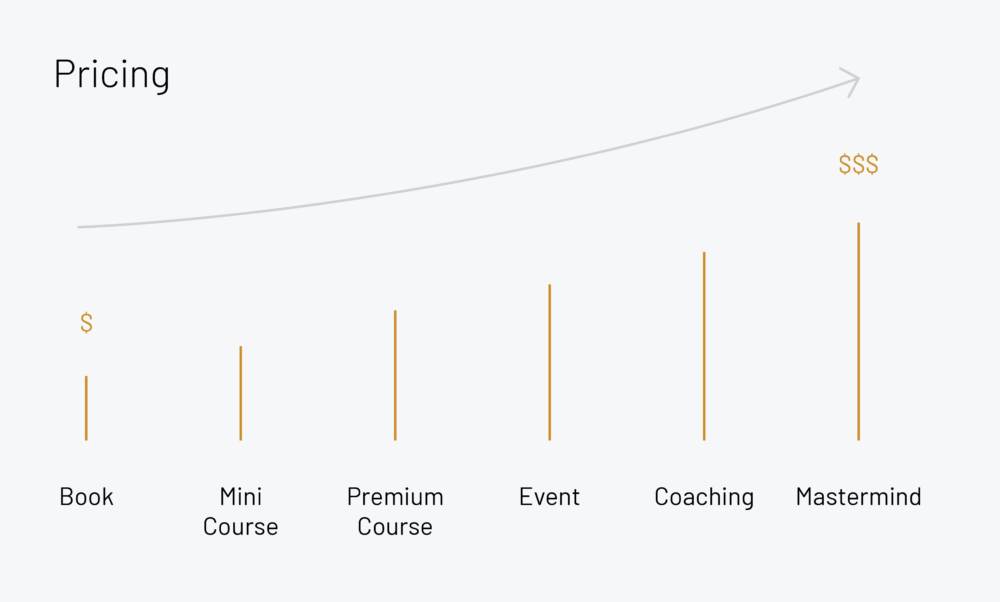
Dana Malstaff, CEO of Boss Mom, for example, helps women learn how to build a business and raise a family at the same time. Her scalable offer (Boss Mom Academy) is a subscription-based membership site that gives her clients access to exclusive content, live training calls, and a community of other moms and entrepreneurs.
In addition to Boss Mom Academy, Dana also sells a book, several online courses, downloadable templates, and live events. Having this range of products and programs at different price points helps her to increase the lifetime value of her clients by enabling them to buy from her more than once, and to provide support to them based on their specific stage of business and budget.
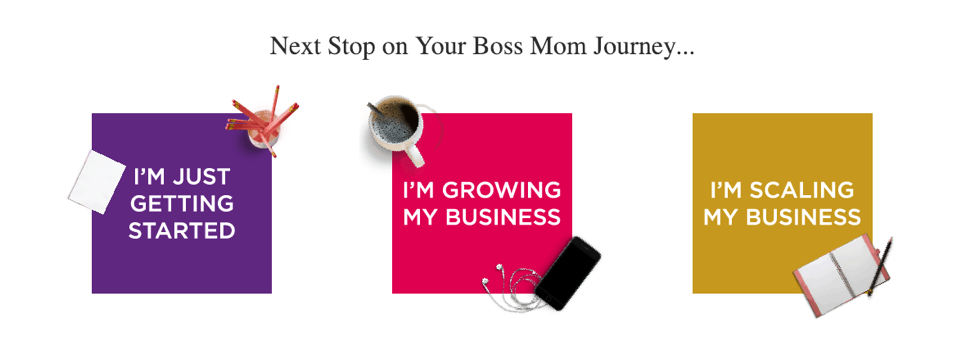
STAGE 5: Systems For Scaling
- Main Objective: To build a business that runs without you (almost)
- Typical Timeframe: 36-60 months (3-5 years)
- Income goal: $500,000 – $1,000,000+
Many entrepreneurs are able to reach Stage 4 without a significant investment in creating systems or building a team. In fact, many of Thinkific’s clients have surpassed 6-figures in annual revenue using a few carefully selected online business tools and software and a lean team (often comprised of a virtual assistant and independent contractors that are hired on a part-time or per-project basis).
Reaching Stage 5, however, requires a significant and fundamental shift in how you operate as an entrepreneur. Whether you sell multiple products and services to offer your clients or you sell one core offer that can be delivered at scale, to reach this stage it is no longer feasible for you to do everything yourself. You’ll need to build systems and hire a core team of people to help run your business for you.
In Stage 5, it’s time to start thinking and operating as a CEO. You will likely continue being the face of your business, but most of the work involved in running your business should not be done by you.
What to focus on in this stage:
1. Optimizing your operations
In the same way that you created a unique process for helping your clients (your “secret sauce”), you should be creating and documenting all of the processes involved in running your business. Every repetitive task that occurs in your business should have a Standard Operating Procedure (SOP) that outlines how that task is performed along with a checklist of all steps involved.
On at least a quarterly basis, you should conduct a thorough evaluation of how you spend your time and ask yourself the following questions:
- What repetitive tasks can I create systems and SOPs for and delegate to others?
- How can I use automation to reduce the amount of time required to conduct specific tasks and processes?
If you want to learn more about building systems and SOPs in your business, the following books are great resources:
- The E-Myth Revisited by Michael Gerber
- Built to Sell by John Warrillow
- Work the System by Sam Carpenter
“The way you multiply time is by spending time on things today that give you more time tomorrow.” – Rory Vaden, Southwestern Consulting
2. Building your team
Your role as CEO of your business is not to learn how to execute every task that occurs in your business by yourself. It’s to identify specific tasks and outcomes that need to be accomplished and to find and hire qualified people to delegate those tasks and outcomes to. Just because you enjoy a specific task doesn’t mean that it is a wise use of your time.
There are 3 types of tasks you should be delegating:
- Things that you know how to do but are not a wise use of your time (so you can focus on high-value activities that grow your business)
- Things that you know how to do but don’t like to do (so you can focus on your strengths)
- Things that should be done but you don’t know how to do
Business consultant Perry Marshall shares a great framework for identifying tasks worth delegating (based on an approximate hourly value of each task) in his book 80/20 Sales and Marketing. Feel free to reference his table as a starting point for deciding what tasks to delegate to others:
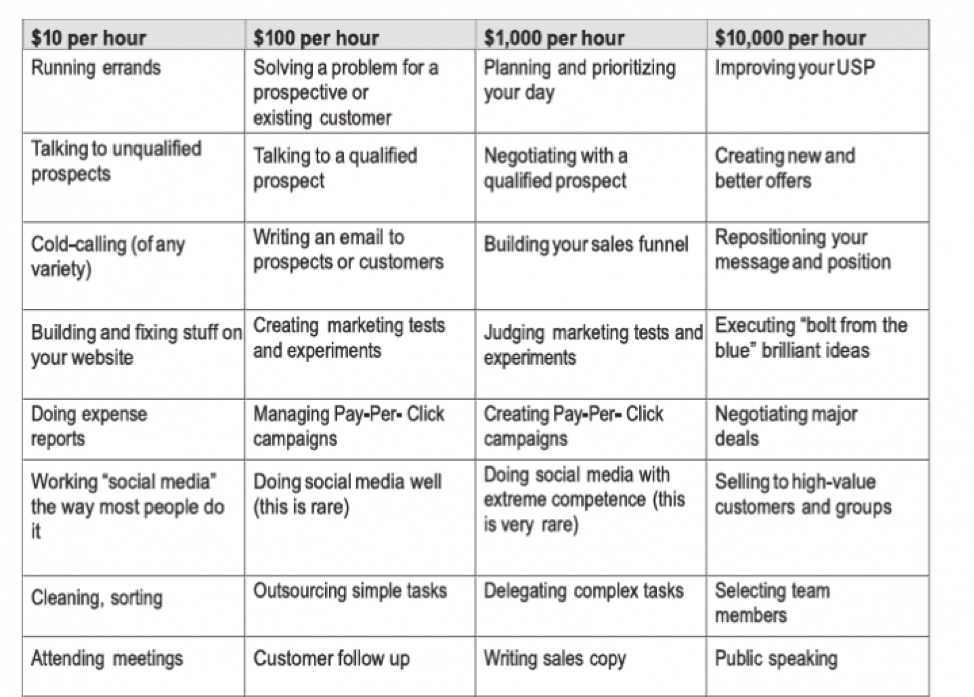
“The typical $100,000-per-year person spends the vast majority of their time doing trivial $10–per-hour tasks, a decent amount of time doing $100-per-hour jobs and occasionally—and somewhat accidentally—executing highly productive, $1,000-per-hour tasks.” – Perry Marshall, Business Consultant
When to delegate outcomes instead of tasks:
You should only delegate a task if you know exactly how that task should be performed and can provide proper training to your team. When you don’t know how to do something yourself, you should be delegating an outcome to someone that has the expertise to achieve that outcome and let them identify the tasks required to achieve that outcome.
For example, if you don’t personally know how to manage a profitable Facebook advertising campaign, you should not be delegating that task. Instead, you should be delegating a specific outcome (for example: to generate $50,000 in revenue using a $10,000 advertising budget) to someone that knows how to achieve that outcome using Facebook ads.
You should also be organizing related tasks and outcomes into specialized roles. Most businesses that reach a million dollars or more in annual revenue are run by a core team of people with the following specializations:
- Operations and/or project management
- Marketing
- Sales and/or partnerships
- Finances/accounting
- Client support and/or community management

To learn more about delegation and building your team, check out our complete guide to outsourcing and hiring virtual staff here.
“The reason you need a seven-figure business is simple: freedom. With freedom, you can truly escape “hustle mode” forever. That isn’t to say you won’t have to work hard and put in the hours, but never again will you find yourself caught in the hamster wheel where every time you scale to a new level, it’s at the expense of your health and sanity. A seven-figure business gives you the freedom to build a world-class team, invest in yourself, regain control of your time (so you have more time to do what you do best) and work “on” your business, rather than get stuck inside it.” – Scott Oldford, Business Strategist
3. Maintaining client success
When you work directly with a small handful of clients at any given time, providing them with a positive experience tends to be very manageable. As long as you are selective with who you work with and you provide the necessary support to help your client achieve their desired outcome, achieving a 100% client success rate is not unrealistic.
But as your business grows to serve hundreds or thousands of clients, maintaining a high client success rate becomes more difficult. The more clients you have, the more complex your business becomes. It will no longer feasible for you to personally interact with each and every client, at least not on a 1-on-1 basis.
As you remove yourself from the client fulfillment process, you become reliant on other people and systems to provide a positive experience for your clients. If you’re not careful, some of your clients can “fall through the cracks” and fail to achieve their desired outcome.
Two investments you should make to help maintain high client success rates:
- A Client Success/Community Manager to oversee the welcoming and continued support of every client
- A CRM (customer relationship management) software to help customize and maintain communication with all clients
In fact, the success of your clients should be one of your main priorities at every stage in your business, not just this one. Successful clients become happy clients, and happy clients are more likely to buy from more than once and refer other clients to you. Happy clients are a critical component of a profitable and sustainable business.
Related: The Top Customer Success Strategies Used by Successful Companies

“We’re not in this business just to get people to buy our stuff. We want them to see the change and the impact and create the success stories.” – Nick Unsworth, CEO of Life on Fire
Final Words of Advice For Building a Business Around Your Expertise
As I mentioned at the beginning of this guide, there has never been a better time to build a business around your expertise. There are people in the world that are struggling to overcome specific problems and achieve certain results on their own. They’re overwhelmed with information. They need your expertise. They need the clarity and the results that your expertise can provide.
As every one of the entrepreneurs we’ve had the privilege of supporting would agree, utilizing your expertise to help others improve some aspect of their lives is incredibly fulfilling. But growing your business will also take a lot of hard work and sacrifice. If you’re not careful, you may find yourself feeling tired and overwhelmed from time to time. It’s just part of the process.
If you stay focused on the right priorities as you transition through each stage of your business, it won’t be long before you build a profitable and sustainable business that makes an incredible impact on your own life and the lives of your clients – just as thousands of entrepreneurs that Thinkific has the privilege of supporting have done.
“The impact sharing my knowledge has had on my business is unbelievable. Because I teach and because I sell my information, I’ve built a multi-million dollar business. I get to travel the world. I get to meet some of the most inspirational humans in my industry. I get to speak at events. I get to have a richer life because I teach that information.” – Lewis Howes, Lifestyle Entrepreneur
Was this guide helpful for you? If so, please share it with your network or leave a comment below. Bonus points if you tell us what stage your business is in!







